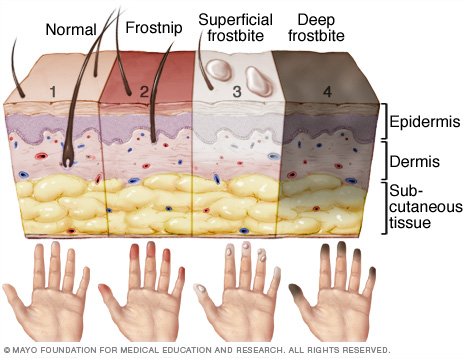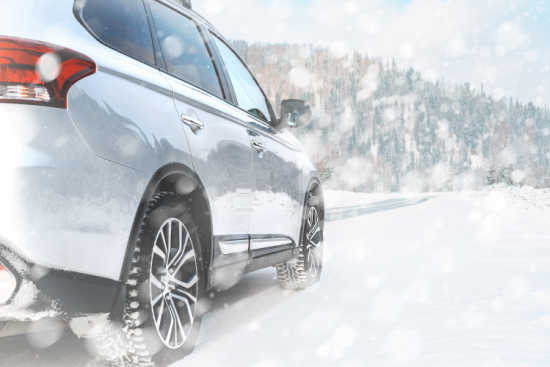Unfavorable weather conditions can create setbacks with winter plans. Have you considered what you will do if your vehicle breaks down during a winter storm or worse, you find yourself stranded in freezing and snowy conditions?
One of the first, and most important things you should know how to do is how to keep your core warm during any harsh winter weather conditions. If you fail to keep your body warm, you could suffer some severe problems.
Frostbite and hypothermia are the two major concerns with winter traveling and having some emergency supplies stashed away in the trunk could be a lifesaver. In a previous article, we covered the stages of frostbite:
“The body (and sort of “mistakenly” so) wishes to protect from the cold in a survival response: the body is willing to sacrifice the extremity to ensure the survival of the individual as a whole. The loss/transfer of blood from these extremities (especially the limbs and the feet and hands) causes the freezing and eventual necrosis (tissue death) of these areas. Frostbite, like burns, is measured in degrees, and they are as follows:

- First Degree Frostbite – only affects the outermost layer of the skin. It is characterized by mild pain with itching and some redness upon return of blood flow to the area. Another name for it is frostnip. First-degree frostbite does not usually result in any long-term damage, although the experience can lead to a long-term susceptibility to cold-weather injuries and extra sensitivity for the afflicted body part/area.
- Second Degree Frostbite – this is a more severe form that is subsequent to first-degree frostbite. In this form, the skin may actually be frozen and assume a rigidity akin to actual ice. After several days (1-3 in most cases) blistering can happen to the areas of the skin that were frozen. These may turn black and rigid; however, it usually heals up completely in about a month or so. Once again, these affected areas may hold a permanent sensitivity to cold and susceptibility to cold weather injuries.
- Third Degree Frostbite – This is characterized by the depth of the skin frozen, as well as structures below the skin. Such structures include muscle, veins, arteries, nerve tissue, tendons, and cartilage. This type of frostbite is most severe and may result in the loss of limbs and structures such as hands/feet and the digits. The greatest cause/contributing factor (in addition to the cold, naturally) is poor or compromised blood circulation to the affected area(s). The shunting that we mentioned earlier is a big contributor, as well.
With third-degree frostbite, there are blisters that become purple and then eventually turn black. The blisters are filled with blood, and the affected areas may need to be amputated. Those who have health factors such as diabetes and are taking certain medications such as beta-blockers place people at high risk for this affliction.
Ultimately, none of us are going to be completely prepared when the bottom drops out and some kind of an emergency occurs. Knowledge and skills should be desirous over materials because with these you can either acquire what is needed or improvise out of what can be fabricated into something useful. That said, having some emergency supplies squared away in your vehicle should reflect the season you are going into. We are big believers in having multiple emergency bags for places you spend large amounts of time – the home, the office, and especially, the vehicle. “Evacuation bags or Bug-Out” bags are a great way to have all the basics with you at all times. Here are some essential gear must-haves:
- Fire-starting equipment
- Small first aid kit
- Compass
- Cold weather gear
- Poncho/tarp with grommets and bungees (for a lean-to)
- Three days of food (minimum)
- Water
- Water-purification equipment (filter, or iodine tablets)
- Knife
- A weapon and ammo
- Radio
With winter emergencies, it is essential that you prioritize protecting your body from hypothermia and frostbite, which we mentioned previously. The first thing you should do is to always dress in layers when you leave during winter conditions. You can always easily remove layers if you feel too warm, but adding them if you fail to bring them with you is impossible!
Layering Clothes Effectively To Stay Warm Outside In Winter
You also want to focus specifically on your feet. If you have to get out of the vehicle, you want to be able to get to your destination safely. Therefore, everyone in the family should have a pair of waterproof/winter shoes or boots while traveling. Winter shoes made from Gore-Tex will protect from moisture as well as cold temperatures. Also, please keep the following items in mind to protect your core body heat if something does go wrong.
I live in a place where it gets very cold during the winter and snowstorms can drop feet of snow in a matter of hours. These are the things that I actually use on a regular basis (the Heat Holders brand of clothing and socks works really well, in my opinion):
- Heavy wool socks, layer with softer more comfortable socks
- Long underwear
- Snow boots (these are the exact snowboots I use in snowy conditions down to -15 degrees Fahrenheit)
- Homesteading arctic muck boots (these are close to the exact muck boots I wear. The style I wear is called the Tremont and they have been discontinued, but I trust the Muck Boot brand over others.)
- Beanie hat (I NEVER leave my house without throwing a winter hat in my Jeep! Winter winds can be harsh and you should protect those ears!)
- Gloves – I drive in a simple glove liner topped with a mitten. This is the best solution I have other than tossing hot hands into your purse, winter vehicle bag, and keeping around the house.
- Hot Hands – We stock up on these every winter! These are extremely helpful when it’s really cold and no glove or mitten is doing the job. Personally, living where it’s so cold, I still have yet to find gloves that will keep my hands warm if I have to be in contact with snow and/or water (deicing the duck pond, etc.) Keep these in your vehicle too!
These items are not the cheapest, however, I have discovered that spending more on your footwear especially will give you peace of mind and keep you comfortable when you must be outside. If you spend more upfront too, your footwear will not only work better but last longer. Nothing is more annoying than your footwear wearing out or failing when you need it the most! This was a hard lesson learned for me! If you have a homestead, share the items that have worked for you during extreme winter conditions!
Read more on what to wear in the harshest of weather conditions.
As well, to truly winterize your bug-out vehicle, also consider having items in place to deal with inclement weather conditions. For instance, car chains for your vehicle, a hazard roadside kit, ice scraper, rock salt or kitty litter, and a cell phone charger would be good to have on hand and will not take up a lot of space.
Get ready for winter travel (and the weather that can come with it) by having everything prepped and ready to go in your vehicle beforehand.
This article was originally published at Ready Nutrition™ on October 26th, 2021








as for helping winterizing your Vehicle .adding Pipe insulation to the heater hoses under the hood.Tie wrap them so not to fall off. greatly improved it’s ability.